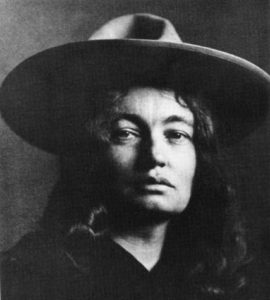
The founder of the Santa Fe Playhouse, Mary Austin, was born in 1868 in Illinois. She focused her writing on Native American culture, social issues, and women’s rights.
She was 23 when she married her husband Stafford W. Austin and for several years they traveled around California’s Owens Valley. Mary quickly fell in love with the desert and the Native Americans who lived in it.
In 1903, she wrote The Land of Little Rain which was an immediate success. This was followed by a collection of short stories, The Basket Women (1904), a romantic novel Isidro (1905), and a collection of regional sketches, The Flock (1906). In 1911, Mary Austin wrote a play called The Arrow Maker which was produced on Broadway at the New Theater, which was meant to “present the Indian more nearly as he is popularly conceived.” And, in 1912, she wrote her bestselling book, A Woman of Genius.
Many more works have been published and it is said that her best writing, which is concerned with nature and Native American life and rights is reminiscent of the work of Ralph Waldo Emerson and John Muir in its transcendental tone and occasional primitive leaning. Mary Austin was very active in movements to preserve Native American culture.
In 1905, Mary separated from her husband and moved to Carmel, California. She later traveled to Italy, France, and England. In England, she met writer H.G. Wells who was a leading preacher of the doctrine of social progress. The trip abroad strengthened Austin’s feminist ideals and added a strong commitment of socialism to her deeply personal and sustaining forms of mysticism.
Upon her return to the U.S., Mary moved to New York and joined a group of writers who gathered at the salons of Mabel Dodge Luhan. A few of Mary’s influencers included John Reed, a revolutionary writer and activist, and Walter Lippmann, one of the most widely respected political columnists in the world.
In 1922, the American novelist and essayist incorporated the Playhouse as the Santa Fe Little Theatre.
It was Mary’s vision, through live theater, to celebrate and preserve the rich texture of the many diverse peoples that made up the Santa Fe community. The Santa Fe Playhouse has undergone many transformations through the decades, but that same vision remains strong. In 1964, the theater found a permanent home in an adobe building in the heart of the historic Barrio de Analco.
With uninterrupted seasons since its founding, The Santa Fe Playhouse has earned the distinction of being “the oldest continuously running theatre west of the Mississippi.”
With its “open-door policy,” the Playhouse provides opportunities for future directors, actors, designers, and technicians to be involved and gain
hands-on experience at the theatre working side-by-side with professionals in their field.
Educational opportunities in theater arts are available throughout the year to children, teens, and adults alike. And, as our season has expanded to feature eight full productions and nearly 100 shows each year, audiences can experience almost every genre of the theatrical arts.
For more information on how you can engage with the Playhouse today, click here.

